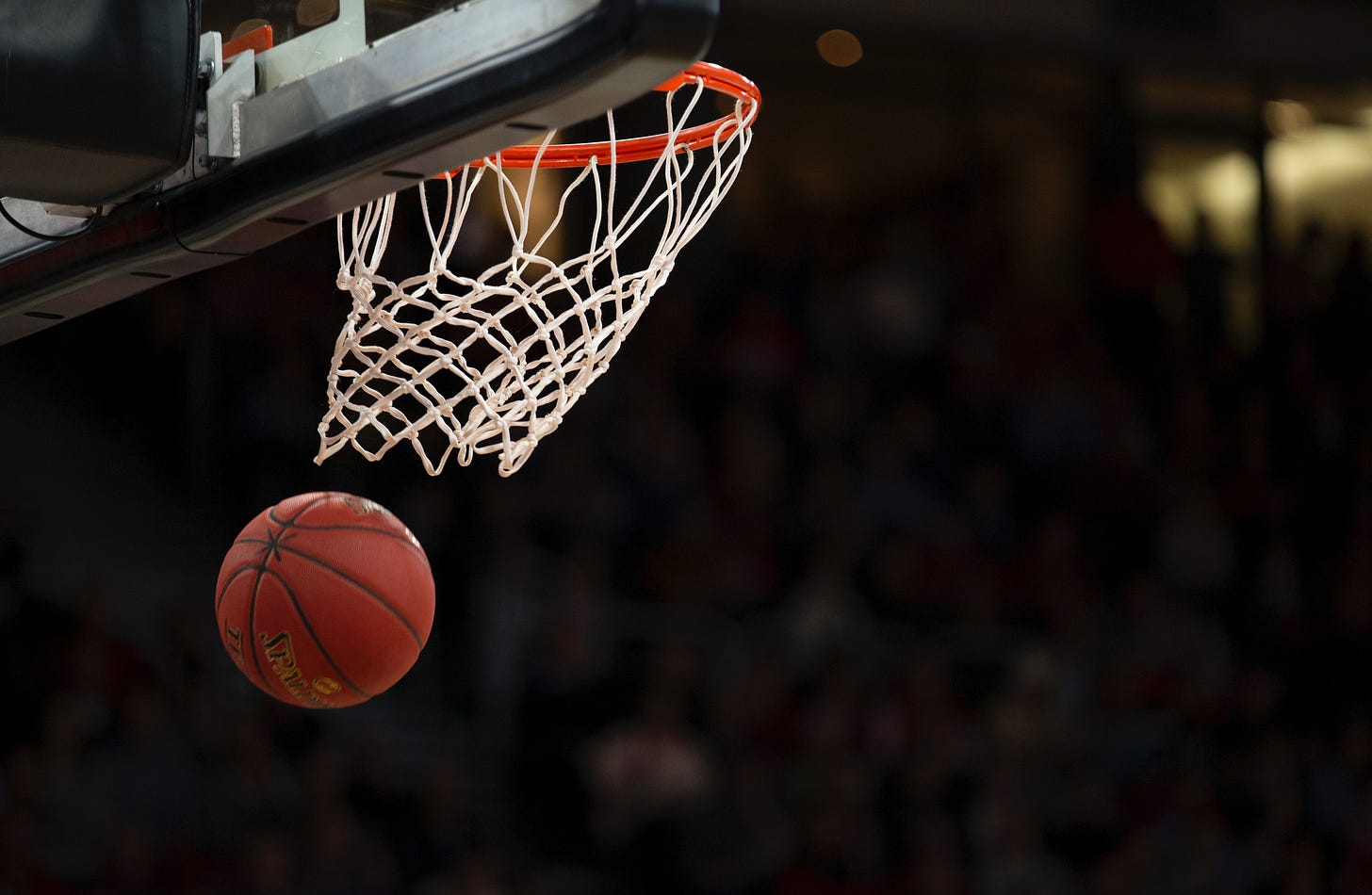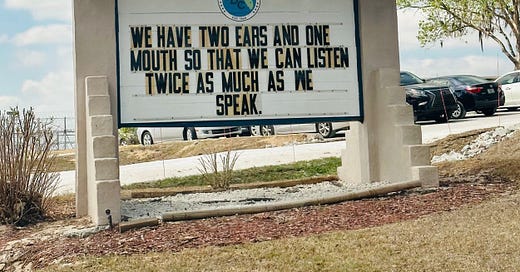Prison Tour, Part I
In this three-part series, I share my experience from the Judge M. Mounts Prison Tour. We visited all levels of prisons in the Florida Department of Corrections--ending at the execution chamber.
Welcome to Part I of III of the Judge Marvin Mounts Prison Tour.
ICYMI, I recently posted a Preface to this series:
Over two days, the tour visited six institutions within Florida’s prison system.1 Throughout the tour, the prisons increased in security. Each of the prisons were generally in the middle of nowhere, away from the neighboring town.
Mental Health (Lake Correctional Institution)
The first stop was Lake Correctional Institution in Clermont, Florida.
Driving up to Lake was a bit deceiving; it looked like you were visiting the vineyard next door until you got very close to the prison entrance.
The main mission of Lake is providing mental health for male inmates of Florida’s prison system of all charges and sentences. The prison’s capacity is 740.
They have outpatient and in-patient treatment, which is contracted through Centurion. The determination of an inmate needing to be in in-patient treatment is made by both inside and outside judges depending on the circumstances. The highest level of inpatient treatment is called “MHTF,” where the inmate is housed in a single cell in a specific unit. One death row inmate is currently housed in that unit and has been there since 2008, as ordered by an outside judge.
However, outside of MHTF, death row inmates are generally not sent to Lake for mental health treatment. Instead, inmates on death row are treated where death row is housed at UCI, which will be in Part III of this series. For example, an inmate in general population who has dementia would likely be sent to Lake for treatment to ensure he does not get lost or disoriented. A death row inmate would not because, I was told, they can be treated in their cell at UCI and won’t get lost there since they’re already in single cells.
Incentivized Program (Sumter Correctional Institution)
The second stop was Sumter Correctional Institution, which is located in Bushnell, Florida.
Incentivized Program
The main mission of Sumter is to serve as an incentivized program (IP). It is one of six (soon to be seven) IPs in the Florida prison system. The prison’s capacity is 1,639.
To qualify for the IP, an inmate must go two years without an infraction, or any disciplinary issue. Inmates of all charges and sentences, including life without parole, can qualify for an IP—except those on death row.
Inmates at Sumter (and IPs generally) have more privileges than at other prisons. For example, there is a building called a game room that has a movie room, a video game room, a “zen room,” and a sports room—things you don’t see at other facilities. The rooms have bean bags where the inmates can watch cable TV, which other facilities don’t have. For the movie room, one officer told me he’s soon going to pick up 100 chairs from a local movie theater that is renovating.
Old video games have a special place in my heart. My beloved grandfather had original video games in his basement my entire childhood. When I saw Mrs. Pac-Man in the game room, I asked an inmate if he’d play a game with me. He said yes to my invitation, and I was so excited. But, unfortunately, as we were starting, the tour had to move on.
Sumter also has a large gymnasium where the inmates can play basketball and other games—something you don’t see at other facilities. In a side room in the gymnasium, one inmate was practicing on his musical instrument.

The IP is a fairly new program within the Department of Corrections (DOC). Walking around Sumter, you could almost forget that you were touring a prison. The Warden and prison administration told us that they have far less behavioral issues than other institutions and there is a communal understanding amongst the inmates that they don’t want to mess it up for the entire group.
If an inmate has a disciplinary issue at an IP, they are sent back to a non-IP facility. It then takes another two years without an infraction for an inmate to qualify for the IP again.
Other Programs
Sumter also has several re-entry, educational, and vocational programs for inmates.
Braille
One of the newest programs is a Braille program. An original group of 20 inmates are signed up for the program, the goal of which is to certify all 20 inmates in Braille and then to produce textbooks for visually impaired children.

The inmates work extremely hard on learning Braille, including taking homework back after the “work day.” The teacher reviews each of their assignments and provides grades and feedback. So far, 4 inmates in the program have received their certifications.
I was able to speak with an inmate who volunteered for this program. He seemed to be in his 50s or 60s (although I didn’t ask) and said he works 7.5 hours per day on learning Braille. He said he likes the program because it is intellectually challenging.
P.R.I.D.E.
Another program at Sumter (and several other institutions) is P.R.I.D.E. Enterprises.
Background
The PRIDE website says:
PRIDE is a self-funded enterprise whose mission makes a positive difference in Florida. We make communities safer and save taxpayers money by training eligible inmates in vocational skills and transitioning them into the job market upon completion of their sentences. This job-centered approach lowers the number of repeat offenders and reduces criminal justice costs for all citizens. Customers invest in Florida when they purchase PRIDE products and services by starting the training-to-job cycle. PRIDE is not run for a profit; instead we combine enterprise with social mission to create a positive impact on communities, people, and customers.
Further:
PRIDE is the only private program of its type in the US and operates as a not-for-profit corporation, with board oversight, to fulfill four missions defined by Florida statute. PRIDE is funded exclusively through the net proceeds from sales of products and services manufactured by PRIDE inmate training programs. PRIDE serves as a model example of the privatization of government functions and reduces the cost of state government for Florida's taxpayers by millions of dollars every year.
I quickly searched the Division of Corporations website to look for more information but wasn’t able to find it.
Information from Tour
Practically, PRIDE operates within Florida’s prisons, employing inmates to make products that are sold to other prisons and outside third parties. For example, the PRIDE furniture program currently has a contract with a local Sonny’s restaurant.
The inmates are paid for their work. Their wages vary, usually somewhere between $0.15-$0.60 per hour from what I gathered. In addition, I was told that a certain percentage (around 10%) of the inmates’ earnings must be paid toward any restitution.
While one would intuitively assume that PRIDE products are, in turn, discounted due to the discounted labor, we were told on the tour that the products PRIDE sells are not sold at a discount.
Re-Entry Support
I did not receive much information on this, but we were told that Sumter provides support to inmates preparing for re-entry in an effort to help them succeed in society.
The tour actually visited seven, but I missed the first stop because I met them at the second stop due to logistics.






